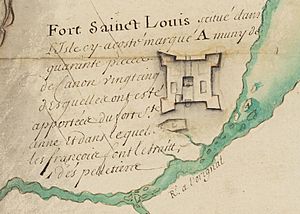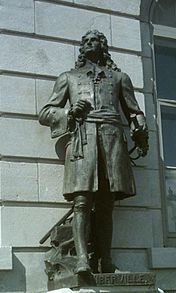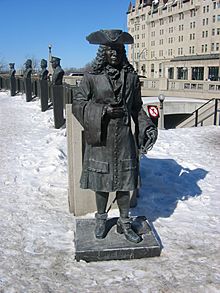Pierre Le Moyne d'Iberville facts for kids
Quick facts for kids
Pierre Le Moyne d'Iberville
|
|
|---|---|
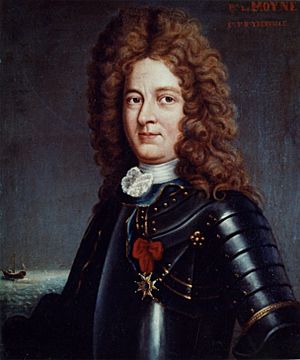
National Library and Archives of Quebec
|
|
| Born | 16 July 1661 Ville-Marie, New France |
| Died | 9 July 1706 (aged 44) Havana, Spanish Cuba |
| Allegiance | |
| Years of service | 1686–1706 |
| Battles/wars | King William's War |
| Awards | Order of Saint Louis |
| Signature | |
Pierre Le Moyne d'Iberville (born July 16, 1661 – died July 9, 1706) was an important figure in the history of New France. He was a soldier, ship captain, and explorer. He also helped manage colonies and was a knight. He founded the French colony of Louisiana. Pierre was born in Montreal to French parents who had moved there. He was also known as Sieur d'Iberville.
Contents
Early Life and Family
Pierre Le Moyne was born in July 1661 in Fort Ville-Marie (which is now Montreal). His father, Charles le Moyne, was from France and was a lord in Canada. His mother was Catherine Thierry.
Pierre had eleven brothers, and many of them became soldiers. His brother Jacques Le Moyne de Sainte-Hélène led French and Native American forces in a raid called the Schenectady massacre. Another brother, Charles le Moyne de Longueuil, Baron de Longueuil, became the governor of Montreal. Jean-Baptiste Le Moyne de Bienville founded the city of New Orleans. Some of his other brothers, Jacques, Paul, and Joseph, also joined him on his expeditions.
Pierre was raised Catholic and went to a seminary school. Even though he was expected to become a priest, he chose a military life instead. At 12, he started working on his uncle's trading ship. Later, he worked in the fur trade and learned how to travel through the wilderness by canoe. He also served as a quartermaster on one of his father's ships.
Adventures in Hudson Bay
Competing for Furs
The Hudson's Bay Company was started by the English in 1670. This company began taking furs that the French wanted. It also threatened to expand into French lands. To compete, the French started the Compagnie du Nord in 1682.
In 1686, the French Governor General, Denonville, decided to push the English out of Hudson Bay. This happened even though France and England were at peace.
Capturing English Forts
Pierre d'Iberville and his brothers, Paul and Jacques, led Canadian woodsmen on an expedition to Hudson Bay in 1686. They were under the command of Pierre de Troyes. D'Iberville played a brave part in capturing the fort at Moose Factory. He also captured an English ship and took over other English posts.
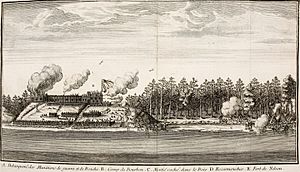
After these victories, de Troyes left d'Iberville in charge with 40 men. When no supplies arrived, d'Iberville went to Quebec and then to France. He convinced the Compagnie to give him command of a ship, the Soleil D'Afrique. He returned to James Bay in 1688 and captured three more English ships.
Battles for York Factory
Back in Quebec, d'Iberville became involved in King William's War. In 1690, he tried to capture York Factory but had to retreat. He then captured the new English base at Fort Severn.
In 1694, he finally succeeded in capturing York Factory for the first time. However, the English recaptured Fort Albany in 1693 and York Factory in 1695. In 1697, d'Iberville captured York Factory a second time after winning a very important battle, the Battle of Hudson's Bay. He never returned to Hudson Bay after this. York Factory stayed French until 1713.
King William's War Campaigns
Raids and Sieges
In 1690, d'Iberville was second-in-command during a raid into New York. This raid ended with the Schenectady massacre. In 1692, he escorted supply ships from France and attacked English settlements along the coast. He captured three enemy ships.
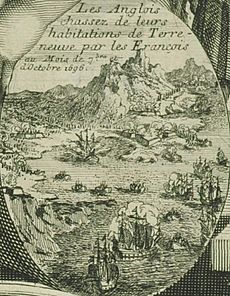
In 1696, he sailed from France with three ships. He helped the governor of Acadia by driving away English ships that were blocking the Saint John River. He then captured Pemaquid, the most northern English settlement in New England.
Newfoundland Campaign
After Pemaquid, d'Iberville sailed to Placentia, the French capital of Newfoundland. On November 1, he began the Avalon Peninsula campaign. During this campaign, he captured St. John's and destroyed most of the English fishing villages. Over four months, d'Iberville destroyed 36 settlements. This campaign was one of the most intense of his career.
Before he could fully control Newfoundland, he was called north to capture York Factory again. Soon after he left, the English arrived in Newfoundland with 2,000 troops and took back their positions. The fighting ended with the Treaty of Ryswick in September 1697.
Exploring and Settling Louisiana
Finding the Mississippi River
In 1682, René-Robert Cavelier, Sieur de La Salle was the first European to travel from the Great Lakes down the Mississippi River to the Gulf of Mexico. The French hoped to create a large empire by connecting the Saint Lawrence and Mississippi rivers. This would help them control more land and block the English.
The French minister for naval affairs and colonies, Pontchartrain, gave d'Iberville the job of finding the mouth of the Mississippi River. La Salle had not been able to find it on his last trip. D'Iberville also needed to build a fort to control the river.

D'Iberville left France in October 1698. He sailed along the Florida coast, past a Spanish base. In March 1699, he entered the Mississippi River Delta. He met some Native Americans who remembered La Salle, which confirmed he had found the Mississippi. He built a temporary fort called Fort Maurepas at Ocean Springs, Mississippi. He left 81 men there and returned to France.
Building More Forts
On his second trip, d'Iberville reached Biloxi in January 1700. He built another "Fort Maurepas" about 40 miles up the Mississippi River. On his way back, he stopped in New York City. He sold many furs there that French traders had given him. This shows how important the future New Orleans area would be as a port.
On his third trip in February 1701, he built a fort at Mobile. Here, Henri de Tonti helped him build good relationships with the Native Americans. D'Iberville left Louisiana for the last time in April 1702. His brother, Jean-Baptiste Le Moyne de Bienville, later founded New Orleans in 1718.
Later Life and Death
In 1702, England and France were at war again. This was called the War of the Spanish Succession (or Queen Anne's War in North America). D'Iberville had become sick with malaria on the Gulf coast.
In early 1706, he left France commanding twelve ships. His forces attacked and damaged the island of Nevis, taking many people prisoner. He then went to Havana, where he was planning an attack against Charles Town, an English settlement. He died suddenly in July 1706, possibly from yellow fever. D'Iberville was buried in Havana.
Pierre d'Iberville was a very important soldier born in Canada. He won many battles but sometimes found it hard to keep control of the lands he had won.
Honours
Pierre Le Moyne d'Iberville was a knight of the Order of Saint-Louis.
Legacy
Many places and things are named after d'Iberville:
- A TV show called D'Iberville was on Canadian television from 1967 to 1968.
- The city of Iberville, Quebec, which is now part of Saint-Jean-sur-Richelieu.
- High schools in Longueuil, Quebec, and Rouyn-Noranda, Québec.
- Streets and avenues in several Canadian cities like Shawinigan, Montreal, Chicoutimi, Radisson, and Alma.
- The D'Iberville metro station in Montreal.
- The provincial voting district of Iberville, Quebec.
- Mont d'Iberville, the highest mountain in Quebec.
- The city of D'Iberville, Mississippi.
- Iberville Parish, Louisiana.
- Iberville Street in New Orleans, Louisiana.
- Several French ships, including a torpedo aviso and a colonial sloop.
- The CCGS D'Iberville, a Canadian Coast Guard icebreaker.
- A statue in Mobile, Alabama, put up in 2002.
- The cafeteria at Northwestern State University of Louisiana.
- Ibervillea, a type of flowering plant.
See also
 In Spanish: Pierre Le Moyne d'Iberville para niños
In Spanish: Pierre Le Moyne d'Iberville para niños


